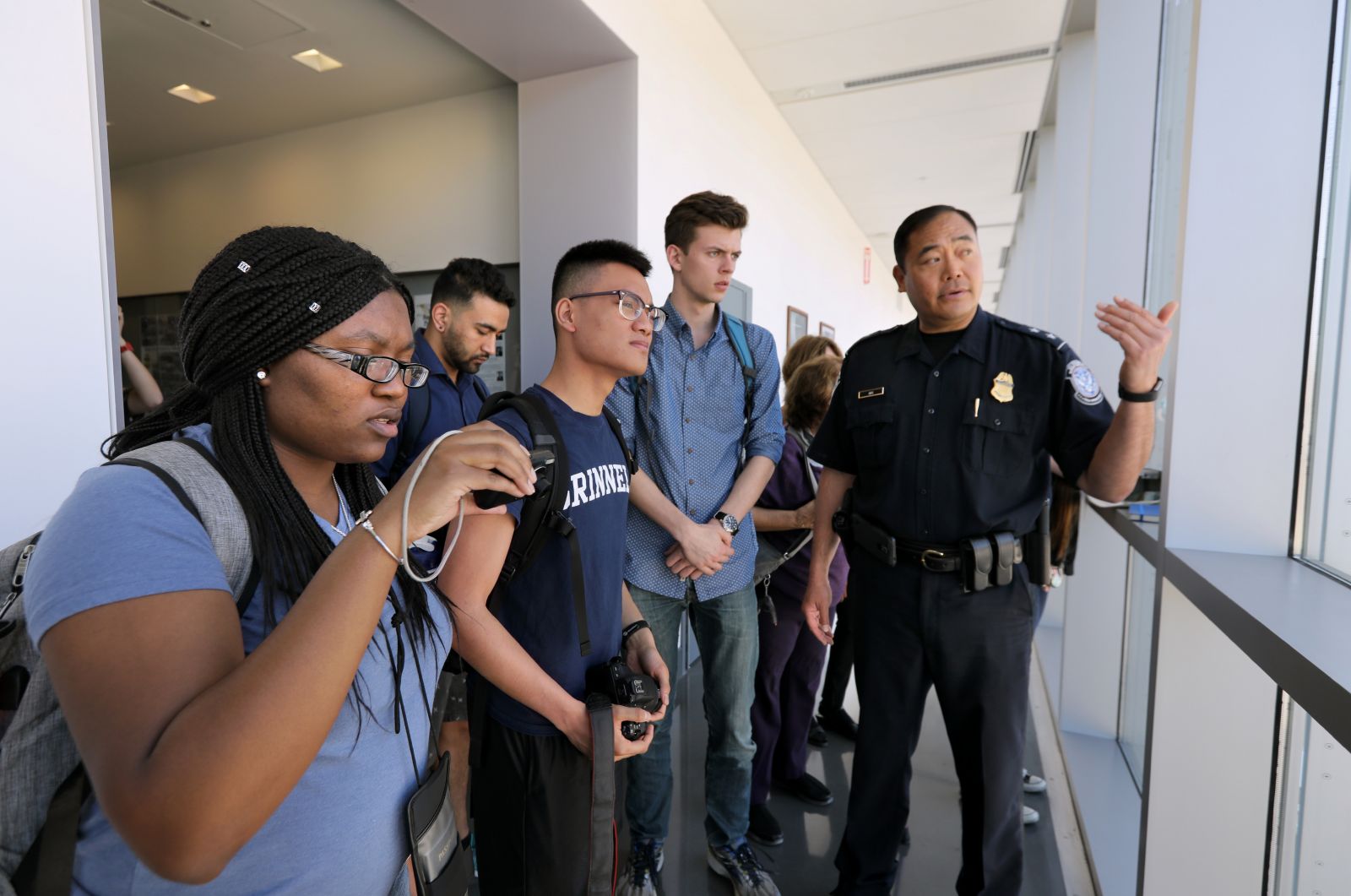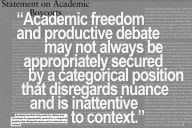You have /5 articles left.
Sign up for a free account or log in.

Grinnell students (L to R) Michael Hewitt, Peter Zelles, Pratik Karki and Jade Bezjak at the Tijuana Estuary
Photo: Charlie Neuman. Courtesy of Grinnell College
This spring proved to be an opportune time for a comparative study-abroad class on border policy.
A group of 15 first-year students at Grinnell College took the class on borders, migration policy and refugees, a semester-long seminar that included an embedded one-week trip to the U.S.-Mexico border over spring break and will conclude with a three-week tour through some of Europe’s borderlands starting later this month.
“Why do people leave home and risk long and dangerous journeys?” asks the course description from the syllabus. “Why do we build walls and intercept migrants on land and sea? What do journeys, walls and government efforts to regulate migration mean to the people affected? This course explores answers to these questions by focusing on the symbolic and physical importance of borders to people on either side of them.”
The two professors co-teaching the class, David Cook-Martín and Xavier Escandell, planned it before President Trump’s election and before he issued his executive orders -- enforcement of which has been blocked by the courts -- barring entry into the U.S. by citizens of six Muslim-majority countries and capping the number of refugees to be admitted. The professors said that while they haven’t let current events take over the class, they’ve been an inescapable part of it.
“Students are extremely engaged,” said Cook-Martín, a professor of sociology and assistant vice president for global education at Grinnell, a liberal arts college in Iowa. “They come to the class asking, ‘What does this executive order mean? How will this play out on the ground?’
“We’ve been trying to get them to think of this in a broader context -- not that there’s anything wrong with moral outrage, but to move beyond that to actually think about migration more broadly, how it has worked over time, and to think about the exceptionality of this moment, to make sure that we don’t let that determine how we think about migration in general. The moment that we’re living in is very particular. If you try to develop a broader understanding of migration that is just focused on this moment, you would end up with a very skewed view of migration policy and politics,” Cook-Martín said.
“It’s unavoidable,” Escandell, an associate professor of anthropology, said about whether Trump has figured into class discussions. “We’re living in a moment where there is debate about building a wall.”
At the same time, he said, “we take a very scientific approach to these issues …. Definitely we’ve debated the contemporary issues involving the immigration regime in the United States and what’s happening with the Dreamers and DACA students, so on and so forth. That’s in the background more than the front. That’s not what we do every day in class, but it’s kind of in the background for all of our discussions.”
Global Learning Tutorials
The class on border policy and migration is funded through a $4 million gift for global learning that Grinnell received from an alumnus and board member, Susan McCurry, and the Roland and Ruby Holden Foundation. The class is one of two comparative seminars with embedded study-abroad components that Grinnell is offering this semester. The other class is on foodways, with trips to China and Russia.
The cost of the courses -- and the travel -- is mostly included as part of students’ regular tuition, though students enrolled in what Grinnell calls the “global learning program tutorials” do pay an additional $400 fee.
There’s a selective application process for the courses. There’s no foreign language prerequisite, in part, Cook-Martín said, because that might exclude some of the kinds of students they want to reach. “We’re looking for a certain level of maturity that would allow students to take on the responsibility of travel, but we’re also primarily looking for students who have not had the experience of travel and would benefit from having that as part of a course,” he said. “We’re attuned to issues of access and equity, so we want to make sure that we’re especially offering opportunities for students from underprivileged backgrounds as well. That’s not exclusive: we do have some students who have traveled before, and bring to the table precisely some of that experience that they can share with their peers.”
The two courses exclusively enroll freshmen. “What we’re trying to do is reach students very early on in their time [at Grinnell], to help them think about the world, in this particular moment of time, and connect their experience to the experience of other people in the world,” Cook-Martín said. “We think it has a number of educational and pedagogical benefits to do that early.”
The global learning tutorials are only in their second year, but Cook-Martín said the first group of 30 participants, sophomores now, applied for other off-campus study programs at a 10 percent higher rate than their second-year peers.
A Comparative Perspective on Borders, Migration Policies and Refugees
The first of the two study tours embedded in the class on borders and migration, a spring break trip to the U.S. Southwest border, included a tour with U.S. Customs and Border Protection officials at the port of entry in San Ysidro, Calif.; a visit to an estuary on the California/Mexico border; a tour of the Cross Border Xpress bridge, a pedestrian skywalk that connects San Diego with the airport in Tijuana, Mexico; lectures at universities on both sides of the border (Arizona State University; the University of California, San Diego; and the Colegio de La Frontera Norte); and a visit to a migrant shelter in Tijuana. There, Cook-Martín said students had the opportunity to talk with recent deportees from the U.S.
“Students were able to put a face to some of the statistics that they’d been reading about,” Cook-Martín said.
The students crossed the border twice, once going into Mexico and once coming out. Cook-Martín had been apprehensive about the return trip, but the crossing into the U.S. went smoothly, even if a couple of students faced unusual questions. “When I was coming back from Mexico, coming into the United States, the border patrol officer asked where I was coming from,” said Jade Bezjak, one of the students enrolled in the course. She replied she’d been at a Mexican university listening to talks on immigration.
“The officer turned to me and said that sounds like an anti-Trump thing,” said Bezjak, who thought it was strange the officer jumped to that assumption. “I just said no, not really, and took a little step back maybe and was hoping he’d let me through.” (He did.)
“It was really enlightening how fragile the border seemed,” Bezjak said of her impressions from the trip. “It doesn’t seem super-strong, yet it’s dividing completely these two nations."
She was also struck by the interconnectedness of San Diego and Tijuana in terms of trade and environmental issues. “People like to see it as the U.S. and Mexico, but there’s really a lot of interconnectedness,” she said. “The further away from the border you are, the less you can see that, but being up close it was really evident.”
For the second international component of the course, students will travel to Germany, Greece and Spain. The class will travel to several cities in Spain, including Granada, Madrid and Seville, and will cross the Strait of Gibraltar to visit Ceuta, one of two Spanish territories located on the African continent that attracts many migrants from the sub-Saharan region.
“It’s a really great site for discussing and exploring issues of borders and border zones,” said Escandell. “They have massive demographic pressure from all these migrants, and then there are these detention centers in Ceuta, so this whole city becomes -- in anthropology we use this term ‘liminal space’ -- a space of waiting to see how they can be transported to continental Spain. After that the hope is that many move further north to other European countries. But that’s obviously not an easy process, so a lot of people stay in Ceuta for a long time, sometimes years, in this sort of semi-detention.”
From Spain, students will travel to Athens, where the plan is to meet with governmental officials and nongovernmental organizations that assist refugees who arrive on the shores of Greece’s islands. They’ll travel next to Germany, the final destination -- both for the Grinnell students and for many refugees -- where they’ll hear from government officials and NGOs in Hamburg and Berlin on how the country is dealing with the Syrian refugee crisis.
Escandell stressed that they are taking pains to avoid the “disaster tourism angle” and that they’ve spent time preparing students to think about the ethical issues of traveling to these sites and to consider their own “positionality” (to use the sociological term). “We’re not going to these places with the idea of interviewing and talking with refugees. We proceed with a lot of caution, but of course you’re in the field and sometimes you have the opportunity to talk to people -- and if that happens in the right way, we can facilitate that as well.”
Escandell said he hopes that students gain an appreciation of the complexities of issues of migration and migration controls and an awareness “of how migration and refugees is a contemporary issue. People are on the move, and often the policy frameworks and policy makers are a little bit behind on how to deal with this crisis. We’ve seen it in Germany. We’ve seen it before in Italy and Spain and Greece. We want to make sure that students understand this tension between policy and reality, the people who are left behind, who fall between the cracks of the system.”
“It’s about creating a comparative framework that students can use to compare the U.S. to Europe,” added Cook-Martín. “We’ve also read about African intramigration so they can start to create a model in their head that would allow them to compare migration and refugee dynamics in different parts of the world -- what’s distinctive about those models and dynamics in a particular region and what seems to be a common thread or common approaches.”
“There’s a rhetoric going on in the United States around these issues that appears very detached from the reality of the border when you actually go there,” said Brian Haggard, a student from Portland, Ore., who's enrolled in the course. “Being able to speak with people who live every day next to the border and being able to read and discuss statistics and literature and ethnographic work about migration creates a frustrating disconnect about the information I’m hearing from academic resources and people who experience it, and politicians and my grandma and the media.”
His grandma? Haggard said his grandparents “thought it would be a brilliant idea” to join him for dinner right after he got back from the spring break trip to the southwest border. It was, he said, “unwise of them, because I didn’t touch my dinner or dessert and debated them with my notes for four hours straight.”









